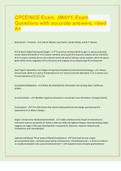Samenvatting
Summary Book Applied Methods of Cost-Effectiveness in Healthcare
- Instelling
- Rijksuniversiteit Groningen (RuG)
Summary of all required chapters for the course 'Economic Evaluation in Healthcare', mandatory course for the MSc BA Health at the RUG. (CH 1-2, 5-11).
[Meer zien]














